UM Regents Criticize “Formula Funding”
University of Michigan board of regents meeting (Nov. 17, 2011): A meeting that began 20 minutes late included two items that spurred discussion among regents: The possible use of a formula to allocate state funding for higher education, and the need for a more comprehensive housing strategy on the Ann Arbor campus.

Regent Andrea Fischer Newman passed around a tray of Block M cookies before the Nov. 17 board meeting. Later, regent Martin Taylor objected to a potential “cookie cutter” approach to appropriating money for higher education, via formula funding. It was fairly clear that he wasn’t referring to these cookies. (Photos by the writer.)
This year, as part of the standard budget appropriations process, the state also has asked universities to provide suggestions for how to implement “formula funding” – a mechanism that’s being considered as a way to standardize appropriations for higher education. Martin Taylor and other regents expressed concerns over the approach, and asked for revisions to a letter being sent from the university to the state budget director that would explicitly state UM’s opposition to this kind of funding model.
Also on the agenda were two requests related to renovations at East Quad on central campus and Baits II on north campus. The topic prompted regent Andrea Fischer Newman to call for a broader strategy for student housing in the coming decades, saying that more attention needs to be given to that aspect of the university. Regent Larry Deitch noted that UM charges a healthy price, and he doesn’t believe there’s full value for UM’s lower-division students when some facilities aren’t up to snuff.
The child rape scandal at Penn State was mentioned at two points during the Nov. 17 meeting. Toward the start, board chair Denise Ilitch read a brief statement on behalf of the regents, saying that the board fully supported president Mary Sue Coleman’s Nov. 16 letter to the campus community. The university plans to use this tragic situation, Ilitch said, for thoughtful re-examination of UM’s values, culture and priorities.
At the end of the meeting, Douglas Smith spoke during public commentary, criticizing the university for not protecting alleged victims of sexual assault by UM athletes Brendan Gibbons and Jordan Dumars. Penn State was only an anomaly because the victims were children, he said. But it’s not an anomaly for university administrators to protect their athletic programs rather than the victims, he added – that’s the norm.
Two others spoke during public commentary. Stephen Raiman, founder of Students Against GSRA Unionization, lobbied regents to reverse their previous vote of support for the right of graduate student research assistants to unionize. And Courtney Mercier, founder of Michigan Student-Athletes for Sustainability, advocated for support to improve integration of the athletic department into the university’s sustainability efforts.
Student filmmakers also made a presentation during the meeting, highlighting video public service announcements (PSAs) they’d made for UM’s “Expect Respect” campaign. After they finished, Ilitch asked whether they’d be interested in making a PSA for the regents, too.
President’s Opening Remarks
UM president Mary Sue Coleman typically starts each meeting by giving highlights of recent accomplishments that the university or its faculty, students or alumni have achieved. She began the Nov. 17 meeting with news that UM alumna Jesmyn Ward had won the National Book Award in fiction for her novel “Salvage the Bones.” Ward received her MFA in creative writing from UM, graduating in 2005. While a student at UM, Coleman noted, Ward won five Hopwood awards, and faculty had expected great things from her in the future. Coleman observed that “Salvage the Bones” had generally been considered a long-shot to receive the award, and that the honor is a real credit to Ward and to UM’s creative writing program.
Coleman also congratulated Ora Hirsch Pescovitz, who was recently elected to the Washington, D.C.-based Institute of Medicine of the National Academy of Sciences. Pescovitz is UM’s executive vice president for medical affairs and oversees the University of Michigan Health System. It’s one of the highest honors in the medical or health professions, Coleman said. Pescovitz received a round of applause from regents and UM staff.
The university’s health system is on the cusp of welcoming patients and families to the new C.S. Mott Children’s Hospital and Von Voigtlander Women’s Hospital, Coleman said. The hospital opens officially on Dec. 4, but staff and faculty have already started moving in. More than 20,000 people from the community attended an open house for the facility earlier this month. No one expected that kind of turnout, Coleman said, but it speaks to the community’s interest in the hospital. She thanked the board for their support of the project.
Highlighting another recent venture, Coleman noted that UM’s Ann Arbor and Dearborn campuses are part of the new Michigan Corporate Relations Network, along with Michigan State University, Michigan Technological University, Wayne State University and Western Michigan University. The intent is to connect university resources with businesses more efficiently, she said. The initiative, funded by the Michigan Economic Development Corp. and the Michigan Strategic Fund, will include several programs designed to spur economic development. Coleman said it’s another way that the university is working to reinvigorate the state’s economy.
Coleman concluded her remarks by noting the recent death of regent emeritus Deane Baker. He was 86. Baker had served as a regent for 24 years, in a tenure that overlapped with regents Larry Deitch and Andrea Fischer Newman. Coleman praised his generosity to the university, and gave her condolences to his family.
State Budget Appropriations Letter
Provost Phil Hanlon briefed regents on the university’s annual letter to the state budget director, outlining the 2013 budget needs of the Ann Arbor campus. [link to .pdf of budget development letter] The 12-page letter, officially from UM president Mary Sue Coleman, makes the case that UM needs state support, noting that the Ann Arbor campus receives 30% less in state funding than it did a decade ago. It also provides details of UM’s cost containment efforts and impact on the regional economy.
This year, the state also asked universities to provide suggestions for “formula funding” – a mechanism that’s being considered as a way to standardize appropriations for higher education.
UM’s letter notes that formula funding, as a new funding model, poses several challenges. From the letter:
The University of Michigan has long expressed concerns about formula funding. When not carefully designed, formulas may favor standardization, ignore economies of scale, and make flawed assumptions about costs being consistent between institutions. The incentives that are embedded into formulas can steer institutions toward uniformity and away from diversity, and this poses serious drawbacks for the State of Michigan. We believe that the diversity of scope and mission seen among the State’ s fifteen public universities is invaluable; it is what enables our universities to meet the State ‘s critical goals for higher education. A formula that fails to recognize the important differences amongst the public universities will undercut the important investments already made in these institutions, and harm rather than help the State.
When the State institutes formula funding, careful planning will thus be required to avoid that potential harm. Specifically, it is critical that the methodology include comparisons of each university to similar institutions. Using the Carnegie classifications and limiting the comparisons to only public institutions will allow for Michigan public universities to be measured against their peers.
The letter goes on to suggest specific performance measures that a formula funding model might include. They include:
- Six-year graduation rates
- Freshman to sophomore retention rates
- Total number of undergraduate degrees awarded
- Number of degrees awarded in fields that will fuel economic growth of the State: engineering, mathematics and natural sciences, health professions (nursing, medicine, pharmacy, dentistry)
- Number of advanced degrees, particularly those awarded in fields critical to maintaining and enriching business, legal, civic, and educational endeavors within Michigan (such as JDs, MBAs, PhDs)
- Sponsored research funding
- Technology transfer and economic development indicators, such as the number of patents filed by university faculty or the number of start-up companies spun out of the university.
Attached to the letter is a copy of the university’s $1.587 billion FY 2012 general fund budget, which the regents approved in June 2011. The budget is based on the assumption that UM will receive $268.8 million in state appropriations for the fiscal year, which runs from July 1, 2011 through June 30, 2012. That amount represents a $47.5 million cut in UM’s state appropriation – a decline of 15% compared to FY 2011, and the lowest amount of state aid received since FY 1964, when adjusted for inflation. The budget included a 6.7% increase in tuition and fees for most in-state first- and second-year undergraduates at the Ann Arbor campus, for a total of $12,634 per year ($6,317 per term).
State Budget Appropriations Letter: Regents’ Discussion
Regent Martin Taylor began the discussion by asking if it’s a fait accompli that the state will combine the budgets for K-12 and higher education funding. K-12 and state-funded institutions of higher education have traditionally received support from different state funding pools.
Cynthia Wilbanks, UM’s vice president for government relations, said that last year – for the first time – the state used some of the School Aid Fund to support higher education. Revenues for the School Aid Fund, set aside to fund K-12 public schools – come mostly from the state sales tax, she said. There remains concern about this move on both sides of the aisle, she said.
Her understanding is that the growth of the School Aid Fund has outpaced growth of the state’s general fund. It’s been characterized as a surplus that could be used to fund all education, not just K-12, she said. Wilbanks said she wouldn’t describe it as a fait accompli, but there’s some expectation that a similar recommendation will be made for the next budget, tapping the School Aid Fund for higher education as well as K-12.
Taylor said he’s talked with some people who are knowledgeable about the state legislature, and they feel it’s a done deal.
He then raised the issue of formula funding, calling it a dangerous area for the state to get into. It’s disturbing to turn funding into a cookie-cutter approach, he said. Wilbanks replied that the first indications of Gov. Rick Snyder’s interest in formula funding were seen in the state’s FY 2012 budget, although that budget appropriated funds for higher education as they’ve been handled historically. Looking ahead, the projected state budget amounts for higher education in FY 2013 are roughly equal to FY 2012, she noted, but specific reference is made in the state budget document regarding formula funding in FY 2013.
Specifically, the state budget document for 2012 and 2013 states:
Beginning in fiscal year 2013, Governor Snyder proposes the use of a formula to allocate university funding. The efforts to develop the formula will be led by the State Budget Director, with input from universities and other stakeholders. The formula will encourage universities to graduate a highly educated workforce in a timely manner and conduct research that contributes to the overall economic strategy for Michigan. [link to .pdf of full budget document]
University officials have been working for the past six months on recommendations regarding formula funding, Wilbanks said. There are serious challenges, including the cookie-cutter issue that Taylor mentioned, she said. Those concerns have been expressed to state officials, she said.
Taylor said it seemed that the merging of K-12 funding with higher education, along with the formula funding approach, were designed to reduce funding to higher education. That’s an attitude that’s popular in Lansing, he noted.
Higher education hasn’t fared as well as K-12 regarding state funding, Wilbanks said. So there’s a debate about the mechanics of appropriations, as well as with formula funding. There have been numerous attempts at formula funding going back decades, she noted, but this is the first time she’s seen a much more serious effort in that regard. She believed the university has the opportunity to influence some of the characteristics that might be considered in the formula.
Hanlon said that the state’s 15 public universities have very different missions, so it’s hard to imagine how a single formula could work. The letter to the state brings up some of these concerns, he said.
Wilbanks noted that over the past decade, there hasn’t been any consistency in the funding of higher education. But the challenges of formula funding are evidenced in other states that use this approach, she said. Applying a formula to the appropriations process doesn’t ensure consistency and predictability. Financial pressure might preclude the ability to “fund the formula,” she said, or legislative priorities might change. These things wreak havoc, Wilbanks said. Throwing a formula into the process simply makes it more challenging, she concluded, noting that she and others have pointed out these issues to state policymakers.
Andrew Richner brought up the issue of the impact on the university’s bond rating. Now, UM has a AAA rating, and it’s important to maintain, he said. The high bond rating allows the university to get better interest rates when borrowing money for projects like the East Quad renovation, he noted. He didn’t see that mentioned in the letter to the state.
UM president Mary Sue Coleman told regents that the university has presented a lot of evidence to state budget officials, and UM executives have talked to legislators and the governor. They’ll continue to do that, she said. UM has experienced a 30% reduction in state funding over the past decade, not adjusted for inflation, she noted. Coleman said she’s proud that through cost cutting and aggressive fundraising, they’ve been able to keep the university financially sound. “But this isn’t a given going forward, and we need to appreciate that,” she said.
Taylor advocated for revisions to the letter that would explicitly state UM’s opposition to formula funding, along with the letter’s existing suggestions for how to implement it. He observed that in the 26-page document, they weren’t putting up much of an argument against formula funding. To him, the letter seems to imply that going in the direction of formula funding is acceptable, he said.
Hanlon noted that the university wasn’t asked if formula funding is a good idea. They were asked for suggestions on how to implement it.
Taylor countered that it was important to explicitly state the university’s view on this. To say nothing “just doesn’t seem to me to be very smart,” he said. The same is true for separate letters from UM’s Flint and Dearborn campuses, he added.
This is the second year that Hanlon has been responsible for drafting the university’s letter regarding its state budget allocations – he was promoted to provost following the 2010 departure of Teresa Sullivan, who was hired as president of the University of Virginia. The letter was also criticized by some of the regents last year. At the regents’ November 2010 meeting. Andrea Fischer Newman told Hanlon that the request for state funding had been too low, and she didn’t feel that they’d taken the opportunity to lay out their case for more funding effectively.
Outcome: Regents unanimously approved the letter, with the provision that it be modified to reflect their concerns. The Flint and Dearborn campuses submit separate letters, which were also approved by regents.
Dorm Projects Lead to Broader Discussion on Housing
Items related to renovations of two University of Michigan dorms – Baits II and East Quad – were on the agenda for the Nov. 17 meeting.
Typically, Tim Slottow – UM’s chief financial officer – is responsible for briefing regents on capital improvement projects. He was absent from the meeting, and Royster Harper, the university’s vice president for student affairs, handled these housing-related items.
Harper began by noting that the renovations were designed to improve the residential experience for students, and to enhance living/learning opportunities. She said she wanted to assure regents that the closing of East Quad and Baits II in the next academic year would not create an overall shortage of beds. She reminded them that Alice Lloyd Hall, a dorm with 530 beds that’s been closed for renovations, will reopen next year. Along with other measures, Harper said UM will be able to accommodate demand for all students, and will have options for graduate students and law school students as well, if they are interested in university housing.

Royster Harper, UM vice president for student affairs, talks with Stephen Forrest, vice president for research.
Regents were being asked to authorize an estimated $11.95 million renovation to Baits II, located on UM’s north campus. The work includes infrastructure updates and reconfiguration of community spaces. The 175,000-square-foot, five-building complex was built in 1967 and houses about 575 students.
The project will be designed by UM’s department of architecture, engineering and construction, in collaboration with Fishbeck, Thompson, Carr & Huber Inc., a Grand Rapids firm. The work is expected to be completed in the summer of 2013. The nearby Baits I residence hall, which houses about 570 students, will be closed at the end of this academic year because of infrastructure issues, and won’t be reopened.
Regarding the Baits II renovations, Harper said the university has been working hard to enhance the vibrancy and appeal of north campus. They’ve created an undergraduate community in the Northwood apartments, she said, and there’s a great living arts program in Bursley Hall. In 2008, some infrastructure work was done at Baits II, but now the university need to do more, she said. The work is even more important in light of the university’s decision to close Baits I, Harper told the regents. That residence hall didn’t provide the kind of experience that students should have, she said, and it wouldn’t have been worth the investment to make the necessary renovations.
Dorm Projects: Regents’ Discussion
Andrea Fischer Newman told Harper that the regents appreciate the investments and upgrades to residence halls, but there’s a bigger issue. She wanted to see a long-term strategic plan for university housing and student life, including recreational facilities and the future of Mary Markley Hall. The new North Quad has had a positive impact, she indicated. [North Quad, located at the southeast corner of State and Huron streets, opened this fall and has been praised by regents in the past. It was the first dorm built by the university since the 1960s, and houses about 450 students.]
Newman said she knows that funding is an issue, but these things need to be dealt with. This aspect of the university needs to be addressed, and not enough attention has been paid to student living, she said, whether it’s freshmen or married couples or students with children. She hasn’t seen an overall plan, and it’s an area that’s important to UM’s competitive position.
Harper replied that a plan for student housing would be brought to the board’s meeting next spring. When pressed by Newman about details – What’s the timeframe for the plan? Will it include suggestions for new dorms? – Harper said the plan would address the university’s direction for student housing in the next 40-50 years. Denise Ilitch, the board’s chair, added that regents will be reviewing a broader master plan for the university at their December meeting, and student housing will be a part of that. Additional details about the student life aspect of that master plan, including housing and recreational facilities, will be discussed in the spring.
Newman said she’s on Harper’s side – she understands that there’s no dedicated funding stream for housing improvements, and that there’s not enough focus on it. Her intent is to push things forward.
Regent Andrew Richner asked for more details on how housing for the freshman class will be handled. Harper said that the living/learning communities in the Northwood apartments 1-2 would be expanded to Northwood 3, where the apartments will be renovated. Alice Lloyd Hall will reopen, adding about 530 beds.
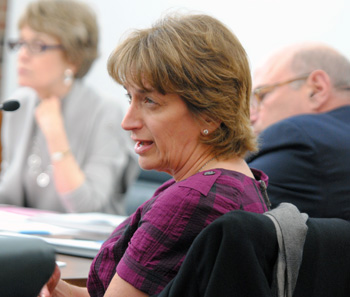
Regent Andrea Fischer Newman. In the background are UM president Mary Sue Coleman and regent Larry Deitch.
Harper said plans are still uncertain for how to accommodate about 300 students, but they’re working on it. Their first priority is freshmen, she said, and there likely won’t be as many returning students living in residence halls.
Larry Deitch told Harper that she does a great job, and he’s sure her staff will make Northwood the best it can be. But it’s not ideally suited for an 18-year-old new undergraduate, he said, and it doesn’t compare with other facilities. The university needs to focus on building more facilities like North Quad, he said. If the money isn’t there, he wants the university to explore public-private partnerships. He noted that he’s said this before, but the idea has been resisted.
The university charges a healthy price, Deitch said, and he doesn’t believe there’s full value for UM’s lower-division students when some facilities aren’t up to snuff.
Newman agreed. As regents, they hear from constituents, she said, especially when housing assignments come out. And most of the complaints are from people who are upset about being assigned to north campus housing. She wondered whether there was any consideration given when making housing assignments, to coordinate with a student’s area of study?
Harper identified the main issue as transportation. It’s a challenge to get back and forth between north campus and central campus in a reasonable amount of time, she said, and the university needs to work harder at improving that situation. She noted that there are students who clearly don’t want to live on north campus. But when a student is first assigned there, they often react to the reputation of north campus being a terrible place to live, which is very different from a student’s experience after they live there, she said. But no matter how wonderful the living situation is, it doesn’t matter if you can’t get back and forth between campuses, she said.
Newman suggested taking a closer look at this situation. Perhaps there are more classes that can be offered on north campus, so that students won’t have to make the trek. She said she thinks there’s a better way to coordinate housing with academics, and noted that feedback on the issue has been “incredibly high-pitched” this year.
Provost Phil Hanlon agreed that they can do better, and that the kind of coordination that Newman mentioned hasn’t been done historically. He reported that there are 17 engineering students in the freshman calculus class that he teaches, and all but one of their classes are on central campus. [The College of Engineering is located on north campus.]
Regent Kathy White spoke up, saying that she’d been an engineering student at a different university, and the last thing she would have wanted was to live next to the engineering building. “That is insane,” she said. White said a lot of engineering students don’t want to be relegated to north campus.
Newman responded that there needs to be a balance. With about 2,200 students living on north campus, there’s a level of concern, she said.
Harper said she understands the concern, and at a minimum, the university needs to fix the transportation piece. [The transportation piece is one that is to be addressed in part through an alternatives analysis phase of a study of the Plymouth-State corridors, headed up by the Ann Arbor Transportation Authority, with support from other partners including UM. The first phase of that study, found some kind of higher capacity transit system would be supportable in that corridor, at least in the area connecting the UM campuses. See "AATA: Transit Study, Planning Update"] Richner also expressed concern about the university’s meal service, saying that issue needs to be addressed as well.
UM president Mary Sue Coleman concluded the discussion by noting that following North Quad and the renovations of other student residence halls, they need to keep those kinds of successes going.
Later in the meeting, Chuck Lewis, a vice president with Integrated Design Solutions, briefed regents on the proposed schematic design for the $116 million “deep” renovation of East Quad, located at 701 E. University Ave., between Hill and Willard. Regents had approved the project at their July 2011 meeting, and authorized IDS as the project’s architect.
The 300,000-square-foot residence hall houses about 860 students and the Residential College, a living-learning community started in the 1960s. The RC will be temporarily located in West Quad, according to a Michigan Daily report. The East Quad renovation is scheduled for completion by the summer of 2013. The project is part of a campus-wide “Residential Life Initiative” first presented to regents in September 2004.
Outcome: In separate votes, regents unanimously approved the renovations at Baits II and the schematic design for East Quad.
“Expect Respect” PSAs
Toward the beginning of the meeting, regents heard a special presentation from four undergraduate filmmakers involved in creating a series of public service announcements for UM’s “Expect Respect” campaign. Josh Buoy, Chris Duncan, Roddy Hyduk, and Stephanie Hamel were on hand to highlight four short PSAs that were played for regents, and to give behind-the-scenes descriptions of the productions.
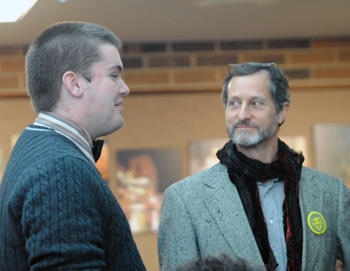
From left: UM junior Josh Buoy with Rob Rayher, who teaches an introductory filmmaking course at the university. Buoy was one of four students who gave regents a presentation about public service announcements they made to promote the “Expect Respect” campaign.
Buoy told regents that they had gotten involved in the project as an outgrowth of an introductory filmmaking course they took with Rob Rayher, who also attended the Nov. 17 meeting.
Most of the PSAs feature students and administrators – and in one, former UM football player Desmond Howard – all with the theme of respecting others. The PSA featuring Howard is called “The Man” and promotes UM’s “Stay in the Blue” program. The program calls for keeping blood alcohol content at .06 or below.
Other PSAs were made for UM’s Spectrum Center (“Huddle Up”) to promote tolerance of sexual orientation, and for the Sexual Assault Awareness Center (“Connections”) to showcase healthy relationships. All videos are posted on the Filmic Productions website, and have been shown during UM home football games this fall on Michigan Stadium’s scoreboard video screens.
After the presentation, regent Denise Ilitch told the students that the board would love to have them do a PSA for the regents. “We’ll talk,” Buoy said.
Conflict-of-Interest Disclosures
Regents were asked to authorize eight items that required disclosure under the state’s Conflict of Interest statute. The law requires that regents vote on potential conflict-of-interest disclosures related to university staff, faculty or students. Often, the items involve technology licensing agreements or leases. This month, the items included three lease agreements, three research option agreements and one licensing agreement.
Lease agreements related to leases at the UM North Campus Research Complex‘s startup “accelerator” with Silicium Energy Inc., Arborlight LLC, and Possibilities for Change LLC. One item related to a licensing agreement amendment with NeuroNexus Technologies Inc. – UM biomedical engineering professor Daryl Kipke is CEO and co-owner of the firm. Items related to option agreements were with the companies ImBio LLC, RiskWatch LLC, and Silicium Energy.
Also authorized was a collaboration between The Ark, a downtown Ann Arbor concert venue, and the University Unions Arts and Programs. The event – an Oct. 7 concert by Vienna Teng at UM’s Power Center – triggered the conflict-of-interest issue because The Ark’s board chair, Kathryn Huss, works for UM as deputy director and chief administrative officer of the Museum of Art.
Outcome: Without discussion, regents authorized all conflict-of-interest disclosures.
Public Commentary
Three people spoke during the time for public commentary at the end of the meeting.
Douglas Smith directed his remarks to UM president Mary Sue Coleman, saying that she didn’t need to travel to Penn State to find a university administration that failed to protect alleged victims of sexual assaults, especially involving football or basketball players. He described a 2009 incident involving UM field goal kicker Brendan Gibbons, who was arrested for an alleged rape of an 18-year-old freshman, and a more recent incident involving UM basketball player Jordan Dumars, who was accused of sexually assault on an Eastern Michigan University student. [Smith had also raised questions about these two incidents during public commentary at the Ann Arbor city council's Feb. 22, 2011 meeting.]
Smith argued that university administrators allowed for the victims to be intimidated so that they refused to cooperate with police. “Penn State was only an anomaly because the victims were children, but the fact that the university administration chose to protect their athletic programs rather than the victims is not an anomaly. It is the norm,” Smith said.
Smith said the board of regents needs to realize that Coleman’s administration is just as guilty as Penn State’s for not protecting the alleged victims in these cases. He asked Coleman what she had done to protect these women, and he distributed police reports that he said he hoped she would read. “Perhaps then you will cheer a little less enthusiastically the next time the football team scores a field goal.” [.pdf text of Smith's full remarks]
Stephen Raiman, founder of Students Against GSRA Unionization, told regents that his group represents about 400 students and is growing. He wanted to talk to them about the implications of their decision to support the rights of graduate student research assistants (GSRAs) to decide whether to organize and be represented by a labor union. [Regents had passed a resolution of support at their May 2011 meeting, over dissent from the board’s two Republican regents – Andrew Richner and Andrea Fischer Newman. UM president Mary Sue Coleman had spoken in opposition to the action prior to the vote.]
Raiman said he appreciated the board’s willingness to listen to students and do what’s best for them, but the problem is that the students objecting to unionization don’t have a voice. They’ve been shut out of hearings held by the Michigan Employment Relations Commission (MERC), he said, so there’s no opportunity to express their opinion.
Letting GSRAs vote on whether to unionize sounds fair, he said, but he and others don’t feel the vote should be held. It can’t be a fair process, given the parties involved, he argued. The Graduate Employees Organization (GEO), which is leading the push for unionization, is backed by the AFL-CIO and the American Federation of Teachers, Raiman said. They have access to professional campaign organizers and public relations experts, he said, whereas his group is small and doesn’t have that expertise. “We’re doing what we can to make our voices heard,” he said, and urged regents to reconsider their vote.
Regent Andrea Fischer Newman said she’d be happy to reconsider, though she was in the minority on the board. She asked whether the university could provide resources to Raiman’s group, in the same way that the university supports groups like the Michigan Student Assembly. Regent Martin Taylor said the answer would likely require research.
Denise Ilitch, who chairs the board, said she thought that the anti-union students were getting support from the Mackinac Center. Raiman told Ilitch that the Mackinac Center has not provided any funding to his group, though they are providing legal assistance to Melinda Day, a UM graduate student who objects to the unionization effort.
[In September 2011, MERC issued a written opinion dismissing a GEO request to conduct an election seeking to represent GSRAs, and denying Day's motion to intervene in the case.]
Courtney Mercier, founder of Michigan Student-Athletes for Sustainability (MSAS), introduced herself as a senior who’s also a varsity athlete on the women’s soccer team, and who’ll be attending UM law school next year. She’s interested in a career in environmental law.
Soon after the athletic department approved the creation of MSAS, Mercier said, she was thrilled to hear UM president Mary Sue Coleman’s announcement about broader campus-wide sustainability initiatives. As a student-athlete, Mercier said, she notices that sustainability isn’t infused into the culture of the UM athletic department. Her group wants MSAS to be a venue for student-athletes to raise concerns and help make the department more environmentally sustainable. They’ve adopted the slogan: “We Play on Planet Blue” – a nod to UM’s Planet Blue sustainability initiative.
Mercier said that most people’s exposure to the university is through athletic events and facilities, and while she has pride in the athletic department, a sustainable athletic department would be even better. She’s not just talking about installing recycling bins, she said, but about reaching out to educate people about sustainable lifestyles. Integrating athletics into the sustainability effort is important, because athletes are the public face of the university. She hoped regents would support the efforts of MSAS.
Present: Mary Sue Coleman (ex officio), Julia Darlow, Larry Deitch, Denise Ilitch, Olivia (Libby) Maynard, Andrea Fischer Newman, Andy Richner, Martin Taylor, Kathy White.
Next board meeting: Thursday, Dec. 15, 2011 at 3 p.m. at the Fleming administration building on the UM campus in Ann Arbor. [confirm date]
The Chronicle could not survive without regular voluntary subscriptions to support our coverage of public bodies like the University of Michigan board of regents. Click this link for details: Subscribe to The Chronicle. And if you’re already supporting us, please encourage your friends, neighbors and colleagues to help support The Chronicle, too!




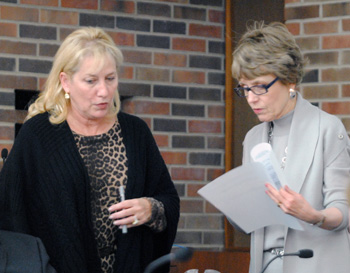
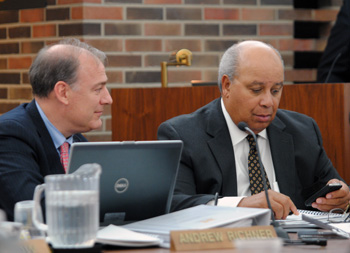
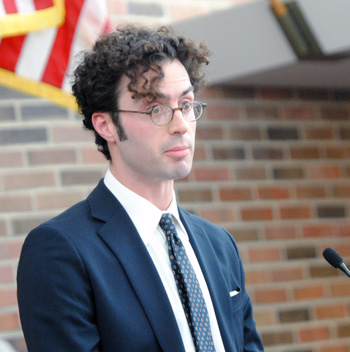
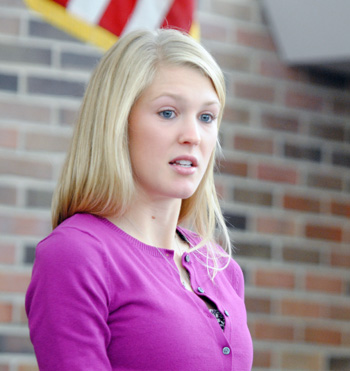
I wonder if the real reason kids object to living on North Campus is not transportation to classes, but access to night life and bars. Sure, Wendy’s and Kroger are open late, but they’re not Rick’s (or whatever place draws them in these days!)
Nothing wrong with that.
I work on North Campus, and while it’s gotten better in recent years, it’s still in many ways a dead zone. Unlike Central Campus, which is pretty integrated with the city, North Campus is really isolated–there’s very little retail nearby, and there are only so many meals you can eat at Quizno’s or Panda before you start to lose it. Bursley has a kind of hothouse culture, and if you fit in it’s great–I have students who love it–but if not, it can be pretty isolating (Baits can be like the Gulag). And transportation back and forth to Central is crowded and, outside of certain hours, can involve a lot of waiting.